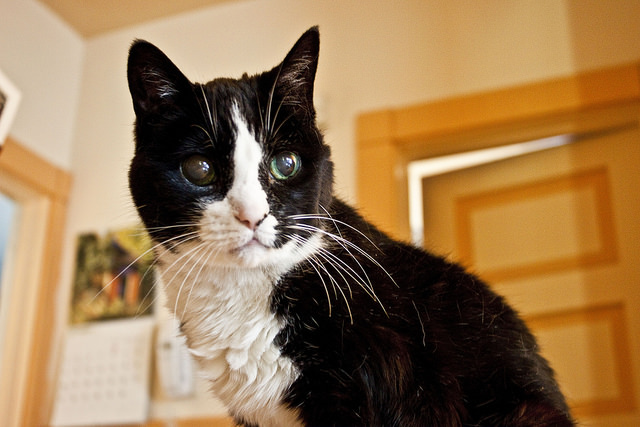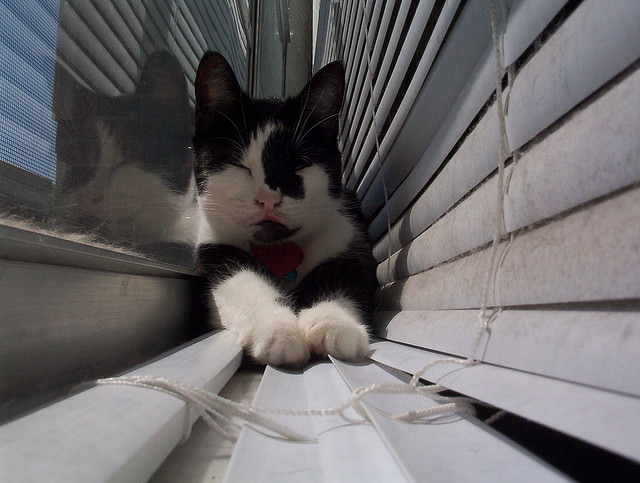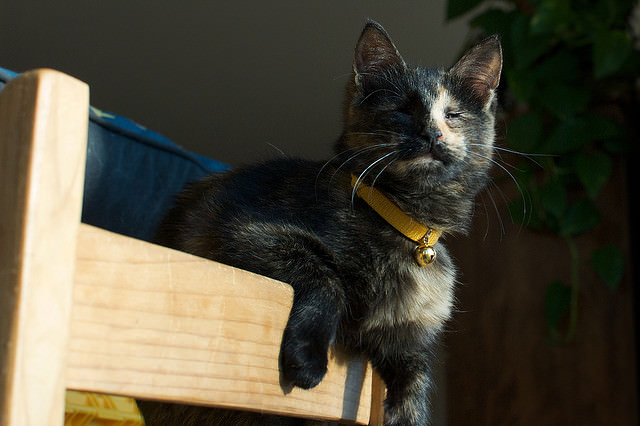Some cats are born blind and some become blind due to an illness or trauma. The good news is that cats are very good at adapting to new situations. Due to their impeccably strong other senses, even complete blindness is manageable. Your cat will learn to depend more strongly on her senses of smell, hearing, and touch to re-learn her environment and troubleshoot dangers.
Whether you are planning to adopt a special needs cat from a shelter (thank you!) or need to prepare for a newly-blind old friend, there are some things you can do to make the transition as easy as possible.
Image Source: Pete Markham via Flickr.com
#1 – Keep her indoors
It’s simply not safe to let a blind kitty roam the great outdoors. Even her heightened senses of smell and hearing won’t keep her safe from many predators and dangers. If your kitty was an outdoor explorer before she became blind and you feel she absolutely won’t be happy as an exclusively-indoor cat, she’ll have to be under close supervision while out there. Consider taking her for walks on a leash or investing in a catio.

Image Source: erik aldrich via Flickr.com
#2 – Keep her environment consistent
Blind cats can get around just fine once they learn where things are located. Changing up the environment of a blind cat, however, can cause her to become withdrawn and anxious as well as put her in physical danger. Living with a blind cat will put a necessary end to your habit of rearranging all of the furniture after your 8pm latte.
While you’re at it, keep her resources in the same spot too! This isn’t a good time to relocate her food, water, or litter box.

Image Source: sylvar via Flickr.com
#3 – Block stairways
Stairways, decks, and balconies can be dangerous to cats who can’t tell that they’re about to tumble over the edge. Keep access doors closed or use baby gates to block access.
#4 – Keep the toilet lid down
Open toilet bowls can be dangerous to a cat who can’t see what they’re jumping into– especially blind kittens who could drown in the small amount of water.

Image Source: Pete Markham via Flickr.com
#5 – Curb the clutter
In addition to keeping the furniture and resources in consistent places, it’ll be important to keep clutter off of the floor so she’s not constantly having to navigate around unfamiliar objects and remap safe routes in her head. Once your cat learns her way around the home it’ll need to stay as consistent as possible. The old saying “a place for everything and everything in its place” should become your new motto.
#6 – Let her know you’re there
Losing her sense of sight can make it harder for her to sense when you sneak up behind her. If she feels like she’s being snuck up on a lot (even by accident) it could cause her to become scared and anxious. You can alleviate this problem by working with her heightened sense of hearing. Start talking to her more, especially if you’re approaching her from behind.

Image Source: Erin Murphy via Flickr.com
It may take a newly blind cat a few weeks to adjust to her new way of life. During the adjustment period, shower her with even more patience and love than usual. You can also help strengthen her other senses by incorporating more toys with bells and rattles into her playtime (sound) and adding more catnip to your home (smell).
Blind cats can live very full and happy lives when we can make these simple changes to accommodate them. Learn more about the happy lives of blind cats and an organization who specializes in rescuing them at www.blindcatrescue.com.

